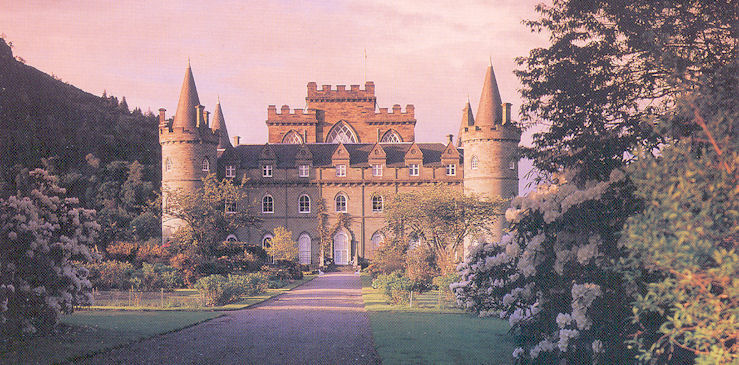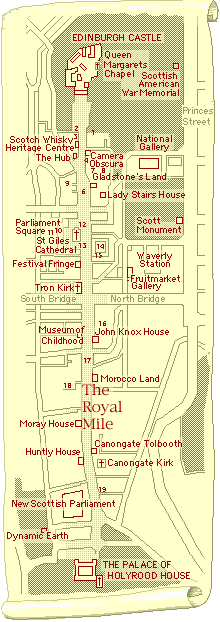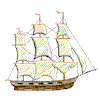Ships from Scotland to America,
1628-1828, also by D. Dobson,
says about the Henry and Francis of Newcastle, "Master Richard
Hutton, 350 tons, 20 guns, from Leith via Montrose, Aberdeen,
and Kirkwall to New Jersey with passengers, 5 Sep 1685 [SRO E72.15.32,
SRO.RH18.l.93]" (SRO = Scottish Record Office, E = Exchequer,
RH = Register House).
Another source:
"In the month of December,
1685, an arrival of more than ordinary interest occurred at the
Point. A vessel freighted with Scotchmen upon whom persecution
had wrought the work of purification and whose souls had been
tempered for patient endurance by sore trials and misfortunes,
anchored in the harbor. They were Scotch Covenanters, members
of the Cameronians, a sect of Scotch Presbyterian dissenters.
James I. had enforced on his Scottish subjects a liturgy which
the people abhorred. This exercise of the royal prerogative led
in 1638 to the formation of a covenant in behalf of the true
religion and freedom of the Kirkdom. The organization of the
Scottish Presbytery was still further completed in the adoption
of the Presbyterian form of church government, a Calvinistic
confession of faith, and the two catechisms, which documents
are still the standard of the Scottish Kirk. The act of English
and Scottish parliaments against conventicles, the legalized
persecutions, with other irritating matters, exasperated the
Covenanters to a point where they thought forbearance ceased
to be a duty. They therefore took up arms against the royal power
and were disastrously beaten, and many executed and imprisoned.
They largely were inhabitants of the Lowlands of Scotland, the
Highlanders being generally adherents of the Roman Catholic religion
or the Church of England.
To these people America offered
a refuge, and through the exertions of George Scot, Laird of
Pitlochrie, early in May, 1685, a ship of three hundred and fifty
tons named the "Henry and Francis" of Newcastle, England,
was chartered. On September 5, 1685, the vessel left the harbor
of Leith, Scotland, having on board nearly two hundred passengers,
some of whom had been on board since the previous summer. The
voyage was long and disastrous, fifteen weeks being consumed
in crossing the ocean. A fever of a malignant type broke out,
and the meat, owing probably to the length of time which had
elapsed since the vessel was chartered, became offensive and
uneatable. As many as seventy died at sea, among whom was George
Scot, Laird of Pitlochie, his wife also, her sister-in-law, Lady
Althernie, and her two children.
"The charge for transportation
as publicly announced was £5 sterling for each adult, and
to each of those who were unable to pay for their passage was
promised twenty-five acres of land and a suit of new clothes
on the completion of four years' service to those who advanced
the requisite amount. After their arrival, considerable difficulty
took place on account of those that had come over without paying
their passage money. An attempt was made to have them serve their
four years' indenture in consideration of the expense incurred
by Scot for their transportation. This they would not agree to,
and suits were brought. The jury returned a verdict for the plaintiff
of £5 sterling and costs. It is a difficult matter to determine
how many of these Scotch Covenanters became permanent residents
of Perth Amboy. A large number of them returned to England; others,
on the accession of William and Mary to the throne of England,
returned to their native land."
In Perth Amboy, New Jersey, a roster
of the banished passengers on the Henry and Frances of Newcastle
was recorded:
"In 1685, George Scot, Laird
of Pitlochie, was given his liberty in Scotland provided he transported
to East Jersey many of the Covenanters who had refused to take
the oath of allegiance to a tyrannical and profligate ruler.
Thus authorized, he proceeded to gather his company from those
confined in the tolbooth of Leith. He had to give security to
land them there prior to September, 1686, and the penalty was
to be five hundred merks in case of failure in any instance.
In May, 1685, Scot chartered the Henry and Francis of Newcastle,
a ship of three hundred fifty tons and twenty great guns, with
Richard Hutton as master.
"On the eve of their banishment,
twenty-eight of them signed the following conjunct testimony,
bearing "That, now to leave their own native and Covenanted
land by an unjust sentence of banishment for owning truth and
standing by duty, studying to keep their Covenants engagement
and baptismal vows, whereby they stand obliged to resist and
testiry against all that is contrary to the Word of God and their
Covenants; and that their sentence of banishment ran chiefly
because they refused the oath of allegiance which in conscience
they could not take, because in so doing they thought utterly
declined the Lord Jesus Christ from having any power in His own
house, and practically would, by taking it, sat, He was not King
and Head of His Church and over them consciences. And, on the
contrary, this was to take and put it in His room a man whose
breath is in his nostrils; yea, a man who is a sworn enemy to
religion; an avowed papist, whom, by our Covenants, we are bound
to withstand and disown, and that agreeably to Scripture:
"When thou art come into the
land which the Lord thy God giveth thee, and shall possess it,
and shalt dwell therein, and shalt say, I will set a King over
me, like as all the nations that are about me, thou shalt in
any wise set him a King over thee, whom the Lord thy God shalt
choose: one from among thy brethren shalt thou set King over
three; thou mayest not set a stranger over three, which is not
thy brother. Deut. 17:14-15.
"They then bore their testimony
against the defections of the day, and for preaching in the fields
and homes, and then signed their names. As Wodrow has given these
names of the banished, we have thought it proper to insert them
here."
The lengthy list of about 125 names
included Robert, David, John, and William Campbell.
"The charge for transportation
was five pounds for each adult and to each of those who were
unable to pay for their passage was issued twenty-five acres
of land and a suit of new clothes on the completion of four years
of service; for children under twelve years of age, fifty shillings;
sucking children free; one ton of goods, forty shillings. These
have been known in American History as 'Redemptioners.' Many
of these passengers had endured much suffering.
"After some delay, the ship
sailed from the road of Leith, September 5, 1685. We hear of
no untoward event until after they had turned the Land's End,
when a fever began to prevail with virulence, particularly among
the prisoners who had been confined in the great vault of Dunnotter.
Many were sick when they came aboard, and the health of others
was endangered by the condition of the provisions laid in by
the Captain. The meat began to putrefy and was not eatable. In
a month the fever assumed a malignant type. Few escaped its ravages,
and three or four bodies were cast overboard every day. Most
of the ship's crew, except the Captain and boatswain, died.
"Pitlochie, who had freighted
the ship, with his lady, died likewise, and so enjoyed nothing
of the gain of nearly one hundred prisoners gifted him by the
Council, and upwards of seventy persons died at sea. Death and
unwholesome food were not the only evils the unfortunate Covenanters
had to encounter, the master of the ship was most cruel to the
prisoners. Those who were placed under deck were not allowed
to go about worship, and when they attempted it the Captain would
throw down great planks of timber to disturb them and endanger
their lives. The ship sprang a leak twice, and frequent storms
added to their anxiety. After the death of Pitlochie, the prisoners
fell into the hands of John Johnston, his son-in-law. Captain
Hutton began to tamper with Mr. Johnstone, and urged him to carry
the prisoners to Virginia or Jamaica, either places presenting
better opportunity for disposing of them than New Jersey, and
offered as an inducement to charge himself with the disposal
of the prisoners and to account to him for them in the productions
of the country. But the wind changed and they were forced to
sail straight for New Jersey. They landed in Perth Amboy, New
Jersey, in the middle of December, 1685, having been about fifteen
weeks at sea.
"Before going ashore, Johnstone
endeavored to stop them by urging them to sign an agreement to
serve four years at that place in consideration of the expense
incurred by the departed Scot. This they would not agree to,
but joined in another protest against their banishment and recounted
their harsh treatment during the voyage. When they came ashore,
the people who lived on the coast and had not the gospel preached
to them, were inhospitable and showed them no kindness. A little
way up the country, however, there was a town (supposed to be
Woodbridge), and a minister settled, and the inhabitants were
very kind to them. When they learned who the prisoners were and
their circumstances, they invited all who were able to travel
to come and live with them, and sent horses for the rest, and
entertained them freely and liberally that winter.
"In the following spring,
John Johnstone pursued them and had them all cited before a legal
tribunal of the Province. After hearing both sides, the Governor
called a jury to sit and cognosce upon the affair, who found
that the pannels had not of their own accord come to that ship,
nor bargained with Pitlochie for money or service, and therefore,
according to the laws of the country, they were assoiled. Those
who had so agreed had their suits come before the Court of Common
Rights, and Captain Hutton was enumerated. The prisoners then
scattered throughout Eastern Pennsylvania, New York and Connecticut,
where they were kindly entertained and found employment according
to their different trades. At different times the persecuted
Covenanters were banished to New Jersey, Delaware and South Carolina,
but in the latter part of the seventeenth century this cruelty
ceased. At this time no organized society of Covenanters has
an existence in New Jersey."
|
John P. Wall & Harold Pickersgill, eds.:
Chapt. IV, "Settlement in the Raritan Valley," in Vol.
I, History of Middlesex County, New Jersey. New York &
Chicago: Lewis Historical Publishing Co., Inc., 1921, pp. 24-25.
- Genealogies of
New Jersey Families, Volume II, A Genealogical Dictionary of
New Jersey, All (see also Alling)
Author: Joseph R. Klett
Publication: Genealogical Publishing Co., Baltimore, MD, 1996
- New Aberdeen; or
The Scotch Settlement of Monmouth County, New Jersey
Author: James Steen
Publication: Journal Steam Print, Matawan, NJ, 1899
Page: pp. 3, 26, 35
- The Original Scots
Colonists of Early America Supplement: 1607-1704
Author: David Dobson
Publication: Genealogical Publishing Co., Inc., Baltimore, MD,
1998
Page: p. 24, 45
- Title: Ships from
Scotland to America 1628-1828
Author: Compiler: David Dobson
Publication: Genealogical Publishing Co., Baltimore, MD, 1998
Page: p. 57
- Title: ElectricScotland:
Castles of Scotland: Inverary, Url: http://www.electricscotland.com/history/castles/inverary.htm
Abbrev: Castles of Scotland-Inverary
- Title: New Aberdeen;
or The Scotch Settlement of Monmouth County, New Jersey
Author: James Steen
Publication: Journal Steam Print, Matawan, NJ, 1899
Page: pp. 4, 35
- Title: Monmouth
County, New Jersey, Deeds: Books A, B, C, D
Author: Richard S. Hutchinson
Publication: Heritage Books, Inc., Bowie, MD, 2000
Page: p. 136 (Book D, p. 211)
- Title: New Jersey
Deeds 1664-1794
Author: Crestview Lawyers Service and General Board of Proprietors
of the Eastern Division of NJ
Publication: New Jersey State Archives, Summit, NJ, 1974
Page: Book D, p. 345; Book D, p. 397; East New Jersey Book E,
p. 378; Book D, p. 391; Book I, p. 230
- Title: East New
Jersey Deeds
Page: Liber D, p. 345 ; Liber E, p. 322; Liber E, p. 200; Liber
I, p. 299
- Title: History
of Middlesex County New Jersey 1664-1920
Author: John P. Wall & Harold E. Pickersgill
Publication: Lewis Historical Publishing Co., Inc., New York
& Chicago, 1921
- Title: History
of the Reformed Presbyterian Church in America
Author: Editor: W. Melancthon Glasgow
Publication: Baltimore, MD, 1888
Page: pp. 228-234
- Title: Monmouth
County, New Jersey, Deed Abstracts
Page: Vol. 1, Sep 1996, pp. 48, 49, 51
- Title: Monmouth
County, New Jersey, Deeds: Books A, B, C, D
Author: Richard S. Hutchinson
Publication: Heritage Books, Inc., Bowie, MD, 2000
Page: p. 42 (Book B, pp. 48, 50); p. 43 (Book B, p. 54); p. 44
(Book B, p. 62)
- Title: Unrecorded
Wills and Inventories Monmouth County, New Jersey: Historical
and Genealogical Miscellany, Vol. VI
Abbrev: Monmouth Co. NJ Unrecord Wills
Author: John E. Stillwell, M.D.
Publication: Reprinted for The Shrewsbury Historical Society,
Polyanthos, New Orleans, LA, 1975
Page: pp. 22, pp. 35, 59, 61, 75
|







